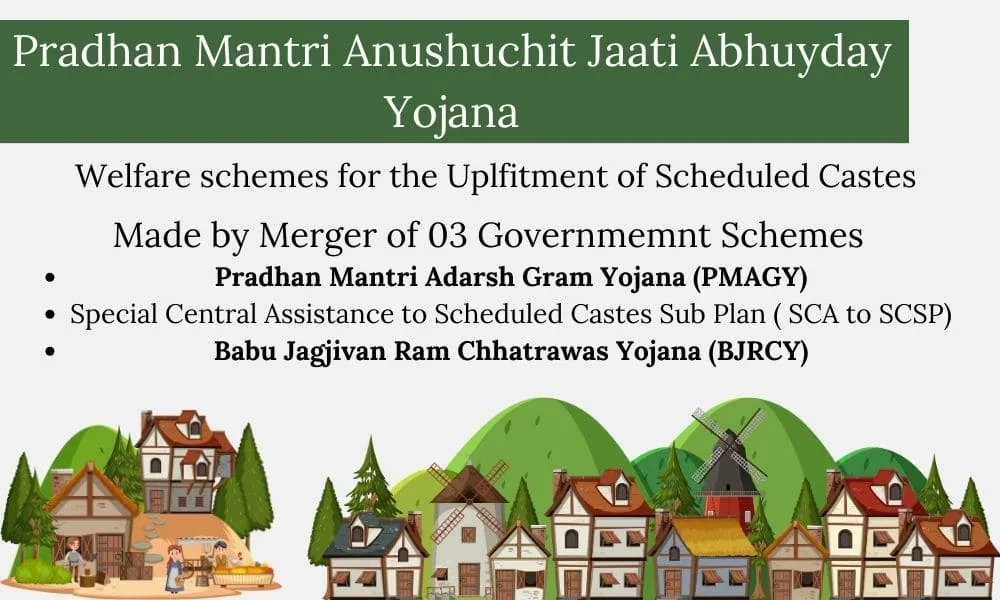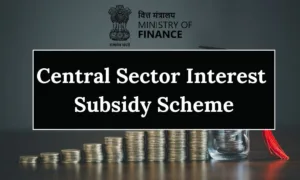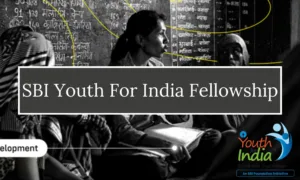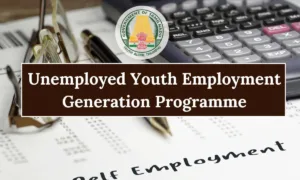Scheduled Castes in India, also known as Dalits, represent a historically marginalized and disadvantaged group within the country’s complex social hierarchy. They are 16.6% of the total population as per the 2011 Census. These communities have faced centuries of discrimination and social exclusion due to the rigid caste system. To address this historical injustice and promote social equality, the Indian government has launched the Pradhan Mantri Anushuchit Jaati Abhuyday Yojana.
This scheme is an amalgamation of 03 Centrally Sponsored Schemes namely
- Pradhan Mantri Adarsh Gram Yojana (PMAGY)
- Special Central Assistance to Scheduled Castes Sub Plan ( SCA to SCSP)
- Babu Jagjivan Ram Chhatrawas Yojana(BJRCY).
In this article, we will discuss Pradhan Mantri Anushuchit Jaati Abhuyday Yojana in detail. Keep reading about the article till the end.
What is Pradhan Mantri Anushuchit Jaati Abhuyday Yojana?
The Pradhan Mantri Anusuchit Jaati Abhuyday Yojana aims to alleviate poverty among Scheduled Caste (SC) communities in India by generating additional employment opportunities through skill development, income-generating schemes, and various initiatives. It also strives to enhance socio-economic development indicators by providing essential infrastructure and services in SC-dominated villages. This scheme comprises three key components:
- The development of SC-dominated villages into model communities (“Adarsh Grams”).
- The provision of grants-in-aid for district and state-level projects aimed at the socio-economic betterment of SCs. These projects encompass infrastructure development in SC-dominated villages, including those selected under the Adarsh Gram component, the construction of hostels and residential schools, and comprehensive livelihood projects that involve skill development, related infrastructure development, and financial assistance to support asset acquisition for livelihood generation.
- The construction of hostels in top-ranked higher educational institutions is based on the National Institutional Ranking Framework (NIRF) of the Government of India, which are funded partially or fully by the Centre, State, or Union Territory governments. This also includes the construction of hostels in schools that receive financial support either fully or partially from these government entities and have been recommended by the Ministry of Education.
Pradhan Mantri Anushuchit Jaati Abhuyday Yojana Objectives
The goals of the program include:
1. Alleviating poverty within the SC communities through the creation of additional employment prospects via skill development, income-generating projects, and various initiatives.
2. Enhancing socio-economic development indicators by ensuring SC-dominated villages have access to necessary infrastructure and essential services.
3. Promoting literacy and increasing SC enrollment in both schools and higher education institutions by providing suitable residential accommodations in quality institutions. Additionally, where necessary, residential schools, particularly in aspirational districts and SC-dominated areas across India.
Pradhan Mantri Anushuchit Jaati Abhuyday Yojana History
Over time, the Government has adopted a multifaceted strategy to promote the socio-economic development of the Scheduled Castes. These initiatives focus on various aspects, including enhancing social empowerment through education, boosting economic empowerment by creating income and employment opportunities, addressing the needs of SC-majority villages, ensuring the effective implementation of protective laws, eradicating practices like manual scavenging, and achieving holistic development by allocating funds in proportion to the population of these groups.
In an effort to uplift Scheduled Caste individuals, who represent a significant portion of the population living below the poverty line, the Department of Social Justice & Empowerment introduced the “Special Central Assistance (SCA) to Scheduled Castes Sub Plan (SCSP)” as a Centrally Sponsored Scheme in 1980. This initiative aims to encourage States and Union Territories to create and implement the Scheduled Caste Sub Plan (SCSP), with the central government providing financial support. Under this scheme, grants are allocated to State Governments and Union Territory Administrations in addition to their existing Scheduled Caste Sub Plan (SCSP) funds.
Pradhan Mantri Anushuchit Jaati Abhuyday Yojana Grant In Aid
The “Grants-in-aid for District/State-level Projects for Socio-Economic Betterment of SCs” scheme, formerly known as the “Special Central Assistance to Scheduled Caste Sub Plan,” is designed to promote the socio-economic development of Scheduled Castes (SCs) by providing grants for various project types. These projects encompass:
Comprehensive Livelihood Projects: These initiatives are aimed at creating a holistic ecosystem to generate sustainable income and foster social advancement exclusively for the Scheduled Castes. These projects are ideally a combination of two or more of the following components:
Skill Development: Offering skilling courses in accordance with the Ministry of Skill Development and Entrepreneurship (MSDE) norms. This may include providing the necessary facilities and infrastructure for government-led skill development activities, and funding for Skill Development Institutions.
Grants for the creation or acquisition of assets for beneficiaries/households: The scheme doesn’t support standalone individual asset distribution. However, if a project includes provisions for acquiring or creating assets required for livelihood generation, financial assistance, in the form of loans for such asset acquisition or creation, can be provided up to a maximum of Rs. 50,000 or 50% of the asset cost, whichever is lower, per beneficiary/household.
Infrastructure development: This involves improving infrastructure related to the project, as well as the construction of hostels and residential schools.
Other infrastructure: Various other infrastructure development projects in villages where SCs constitute the majority are also eligible for funding.
Pradhan Mantri Anushuchit Jaati Abhuyday Yojana in News | What’s New?
In the recent release of the Press Information Bureau, the Ministry of Social Justice and Empowerment has showcased the achievements during the current Financial Year 2022-23 and informed regarding the scheme for 2023-24.
Achievements during the current Financial Year 2022-23:
- Within the Adarsh Gram Component, a total of 1,260 villages have been designated as Adarsh Grams during the current fiscal year of 2023-24.
- Nine new hostels have been approved under the Hostel component of the scheme.
- Perspective plans for seven states have received approval under the Grant-in-aid component during the current financial year.
Special Provisions
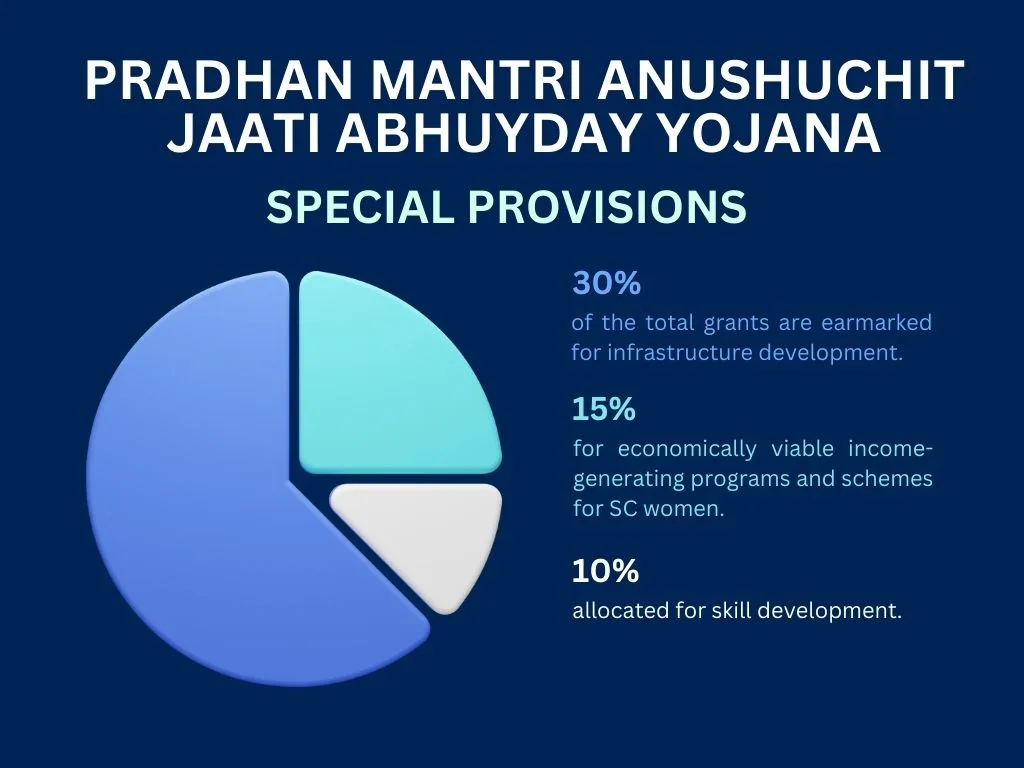
- Up to 15% of the total grants are allocated exclusively for economically viable income-generating programs and schemes for SC women.
- Up to 30% of the total grants are earmarked for infrastructure development.
- A minimum of 10% of the total funds is allocated for skill development.
- The scheme aims to encourage the establishment of SC Women Cooperatives engaged in the production and marketing of consumer goods and services.
Pradhan Mantri Anushuchit Jaati Abhuyday Yojana Eligibility Criteria
Individuals from the Scheduled Castes who are living below the poverty line can avail the benefits offered by various Income income-generating schemes and Skill Development Programs.
For Infrastructure Development, villages with 50% or more SC population are eligible to receive grants under this program.
In terms of determining the poverty line and identifying SC families living below it, the criteria set forth by the former Planning Commission and the procedures established by the Ministry of Rural Development for beneficiary selection through the Panchayati Raj institutions should be followed.
Pradhan Mantri Anushuchit Jaati Abhuyday Yojana Components
1. Income Generating Schemes
- Promote Entrepreneurship among SCs
- Offer a subsidy of Rs 10,000 per beneficiary or 50% of the loan
2. Skill Development Programs
- Enhance Capacity Building through training
- Provide skill training aligned with the National Framework
3. Infrastructure Development
- Implement Development Programs in SC-majority villages
- Address critical gaps in overall development
4. Monitoring and Evaluation
- Allow the utilization of up to 4% of the total Grants-in-Aid by States/UTs for supervision, monitoring, and evaluation of economic development schemes supported by SCA funds.
5. Administrative Expenses
- States/UTs can allocate up to 1% of the total SCA funds for various administrative expenses to assist the State Scheduled Caste Corporation in supervision, monitoring, and evaluation activities.
Pradhan Mantri Anushuchit Jaati Abhuyday Yojana Component Wise Fund Allocation
When allocating funds within the framework of the PMAJAY Scheme, priority is given to meeting the actual needs of the selected villages under the ‘Adarsh Gram’ component. The funds are distributed among the various components of the scheme as follows:
Adarsh Gram: Up to 50% of the total allocated funds under the scheme for Gap-filling activities in selected villages.
Administration, Monitoring, and Evaluation: Up to 5% of the total allocated funds are reserved for establishing and operating Technical Support Groups (TSG) and Project Implementation Units (PIU) at the Central, State, and District levels.
Construction/Repair of Hostels (not covered by the States): Up to 2% of the total allocated funds are earmarked for this purpose and are directly released to the implementing agencies by the Ministry.
Grants-in-aid for Projects at District/State: The remaining funds under the scheme are provisionally allocated to States and Union Territories (States/UTs) based on two criteria: 50% weightage to their Scheduled Caste (SC) population and the ratio of the Special Component Plan (now known as State SCSP) to the Annual Plan, compared to the SC population in the States/UTs, with 50% weightage.
Regarding component Administration, Monitoring, and Evaluation: 1% of the funds are utilized at the Central level, and the remaining 4% of the funds, proportionate to the applicable Central Assistance for the respective components of the scheme, are released to the State/UT Government.
In cases where savings are realized under any component, except for component Administration, Monitoring, and Evaluation, these funds are reallocated among other components or other States based on viable proposals, provided that they meet the conditions outlined in the scheme guidelines.

PM Kisan Samman Nidhi Yojana 2023 | All You Need to Know
Pradhan Mantri Krishi Sinchayee Yojana 2023 (PMKSY) | Components, Benefits and Application Process
Pradhan Mantri Fasal Bima Yojana [2023] | This is How Government Saves Farmers in Case of Crop Loss
